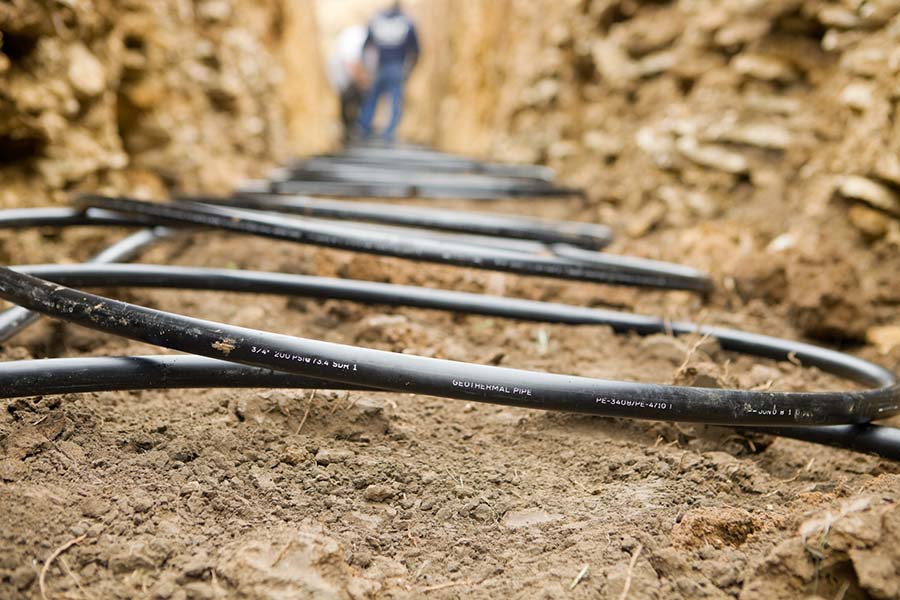In the last chapter, we explored the immense power of deep geothermal—a technology for the lucky few in geological “jackpots.” Now, we turn to technology for the rest of us. Shallow geothermal, or geo-exchange, is the versatile, “build-anywhere” solution that makes geothermal heating a practical reality for growers across the country and around the world.
In fact, geothermal’s versatility is its greatest strength. Even in regions famous for their deep geothermal hot springs, geo-exchange is often the most practical and affordable choice for an individual greenhouse or small commercial operation. This chapter is a close look at the technology that brings geothermal heating and cooling within reach for nearly everyone.
Using the Ground as a Thermal Battery
The concept behind shallow geothermal is simple: the top layers of the Earth’s crust absorb and store solar energy, continuously topping it off whenever the sun is shining, not unlike your car’s battery that automatically charges whenever the engine is running.
The stored solar energy naturally creates a stable temperature zone (typically 45-75°F) a few feet down, just below the frost line. This is where the warmth comes from for geo-exchange systems.
It’s important to note that a geo-exchange system doesn’t actually create heat; it just moves it efficiently to where it’s needed. The remarkably simple design requires only three main components: an underground pipe loop, a circulating fluid, and a ground-source heat pump. This design supports two distinct modes:
Winter Heating
When the heating function is active, a water-based fluid circulates through pipes buried several feet underground, where it absorbs the stored warmth before flowing to a ground-source heat pump inside the greenhouse. Just like your home heat pump, it operates like a refrigerator in reverse, concentrating the heat and releasing it into the greenhouse.
Summer Cooling
In summertime, the process reverses. The heat pump lowers the greenhouse’s ambient temperature by pulling warm air out of the greenhouse and transferring heat to the fluid. As the fluid circulates underground, the cooler Earth absorbs the excess heat, much like a giant heat sink.
This process of heat exchange allows a single system to provide reliable, sustainable, and energy-efficient heating and cooling year-round while dramatically cutting fossil fuel consumption.
Understanding Open and Closed Loop Systems
If a shallow geothermal system is the best option for you, you’ll need to decide how the system will physically interact with the ground. There are two primary designs: closed-loop and open-loop. While both use a heat pump to move energy, they access the Earth’s stable temperature in very different ways.
Closed-Loop Systems: The Standard Approach
A closed-loop system is the most common and versatile type of geo-exchange system. It circulates the same heat-transfer fluid (a mix of water and antifreeze) continuously through a sealed network of pipes buried in the ground. Essentially, it operates like the radiator in your car; the same coolant circulates over and over again to move heat, never leaving the sealed system.
The fluid absorbs heat from the ground (in winter) or deposits heat into the ground (in summer) through the walls of the pipe. Because it’s a self-contained system, it’s reliable and doesn’t depend on the quality or availability of local groundwater.
Open-Loop Systems: Using Groundwater Directly
An open-loop system does not use a sealed loop of pipes. Instead, it pulls groundwater directly from a well, a large pond, or a similar source. The water is drawn through the heat pump, where heat is either extracted or added, after which the water is discharged back into the environment, usually into a separate discharge well or a nearby stream.
You might think of it like a factory that uses river water for cooling; it uses a constant supply of natural water that passes through the system once and then flows back into the environment.
While this can be a very efficient method, it comes with a strict set of requirements designed to protect your system and the local environment:
- You must have a plentiful source of clean groundwater.
- The water chemistry must be low in minerals and corrosive elements to avoid damaging the heat pump.
- You must have a legal and environmentally sound place to discharge the water, which is returned at a higher temperature than when it was withdrawn. The discharge point is usually constrained by local regulations.
Because of the strict requirements associated with open-loop systems, closed-loop designs are the most common, reliable, and versatile choice for the vast majority of residential and commercial greenhouse projects. We’re going to focus on that option, going forward.
Up and Down or Side to Side? Putting Pipes in the Ground
Once you’ve decided on a closed-loop system, the final major design decision is how to physically arrange the pipes in the ground: horizontal or vertical. While this may sound like a trivial decision, it’s critical because the system’s performance hinges on installing hundreds, or even thousands, of feet of pipe. This required length provides the necessary time and surface area for the heat exchange to actually happen. The choice between horizontal and vertical is simply about the most practical and cost-effective way to fit the required amount of pipe onto your property.
Horizontal Loops: Sprawling Out
A horizontal loop is usually the preferred choice when you have a lot of open land—it’s less work and therefore cheaper to install. You’ll use a backhoe or trencher to dig a series of long trenches, typically 4 to 6 feet deep, well below the local frost line. Next, the pipe loops are laid out along the bottom of the trenches before being buried. To fit more pipe into a smaller area, the loops are often arranged in an overlapping, “Slinky” like configuration.
- Pro: Lower installation cost, as it uses standard excavation equipment.
- Con: Requires a very large, clear land area and is highly disruptive to the landscape during installation.
Vertical Loops: Drilling Down
A vertical loop is the ideal solution for projects with limited surface space. A well-drilling rig is used to bore one or more deep, narrow holes, typically 150 to 450 feet straight down into the earth. After a U-shaped loop of pipe is inserted into each borehole, the hole is filled with a special grout to ensure good thermal contact with the surrounding ground.
- Pro: Has a minimal surface footprint, preserving your existing landscape and making it ideal for smaller properties.
- Con: Significantly higher installation cost due to the need for specialized well-drilling equipment and personnel.
The choice is a straightforward trade-off: If you have plenty of open land and want to minimize costs, a horizontal system is the likely choice. If you have limited space or want to protect your existing landscape, a vertical system is the superior, albeit more expensive, option.
Geoexchange: The Go-Anywhere System
The single greatest advantage of a shallow geothermal system is summed up in its nickname: the “go-anywhere” technology. Because it relies on the stable, moderate ground temperature created by stored solar energy, it is not limited to specific geological hot spots. From a small hobbyist greenhouse in a suburban backyard to a massive university campus in the Midwest, geo-exchange is a proven and versatile solution for sustainable heating and cooling.
Of course, while the energy source is everywhere, a successful installation still requires careful planning and a professional design to ensure the system is correctly sized for its purpose. However, unlike deep geothermal, a shallow geo-exchange system can be a realistic DIY-assisted project for an experienced property owner. The excavation and laying of a horizontal loop field, for example, can often be tackled by a skilled individual with the right equipment, while the final heat pump connection and system commissioning are left to a certified professional. This makes geo-exchange a uniquely accessible path to sustainable greenhouse heating.
The Bottom Line: The Pros and Cons
Shallow geothermal is the most practical and accessible form of geothermal energy for most growers. Here are its key trade-offs.
Pros
- Can be installed in nearly any geographic location, regardless of local geology.
- Provides both highly efficient heating in the winter and cooling in the summer from a single system.
- The technology can be sized for anything from a small hobby greenhouse to a large commercial facility.
- A ground-source heat pump uses one unit of electrical energy to move three to five units of heat energy, making it incredibly efficient.
Cons
- The cost of excavation or drilling and the heat pump itself is a significant investment compared to conventional heating systems.
- Horizontal systems require a large, open land area, while vertical systems require access for heavy drilling equipment.
- The system’s performance is directly affected by local soil type and ground moisture levels.
Looking Ahead
Now that you have a working understanding of the powerful heating and cooling “engine” of a geo-exchange system, the next question is what kind of structure will it be powering? The design of the greenhouse itself is the next critical piece of the puzzle. Our next chapter will review the building science of a geothermal greenhouse, from foundation and insulation to optimizing for the winter sun.




